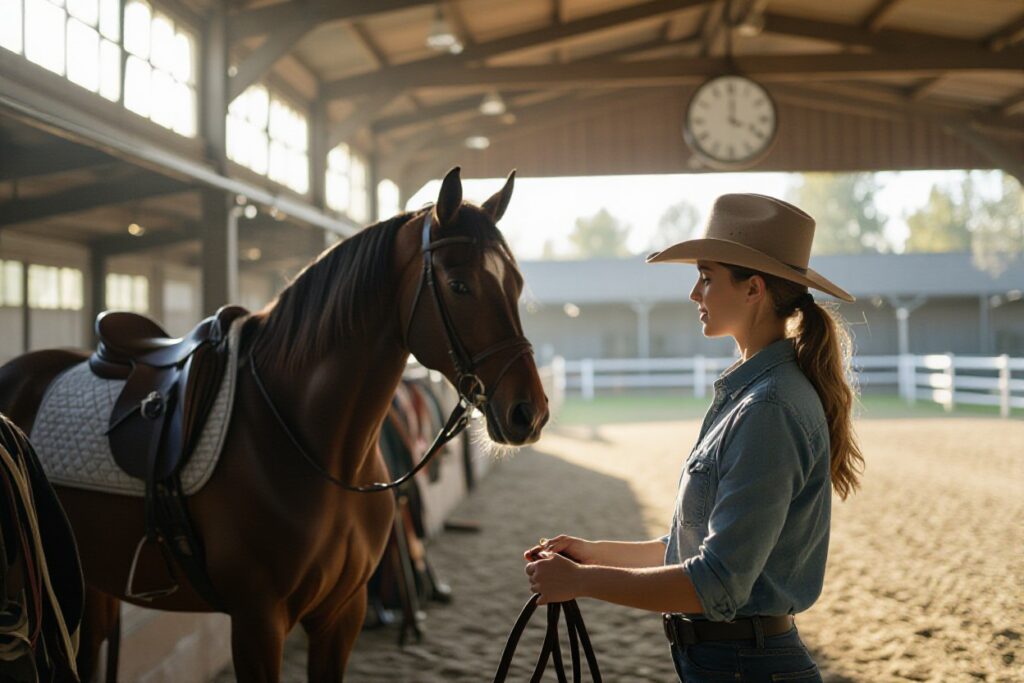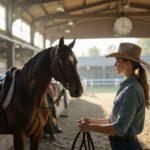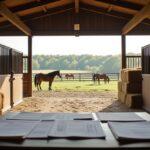Trainers like you begin before dawn balancing barn chores, exercise sessions, and client meetings in a tightly scheduled routine that shows what horse trainers do in a day and how your schedule unfolds: early-morning care and focused training sessions, midday administration and farrier/vet coordination, then afternoon schooling or specialized work. You must manage the physical demands and real danger of working around large animals while cultivating clients and horses. The role also offers strong income potential and clear paths for career advancement if you prioritize skill development and reputation.
The Early Start
You roll into the barn before most people are awake, often between 4:30–5:30 a.m., handling the first feeding, turnout and safety checks so training can begin on time; expect to feed and turnout anywhere from 6 to 20 horses depending on the yard, top up water, clear high-traffic aisles, and prep the arena while light and footing are optimal.
Waking Up Before Dawn
You set alarms for 4:00–5:30 a.m., head straight to the barn, and in the first hour you’ll typically feed concentrates, check automatic waters, and move horses to paddocks or solariums; in smaller operations you might be alone feeding 6–8 stalls, while larger yards expect you to coordinate teams and stagger tasks to avoid chaos in dim light.
Preparing for the Day
You do a swift but thorough gear and barn check: inspect saddles, bridles, girths and lead ropes, clean bits, test arena lighting, and confirm the day’s ride times; tack failure is a real hazard, so spotting frayed stitching or cracked leather early prevents accidents during the first ride.
Your prep list is practical and numbered—check saddle tree fit, girth elasticity, stirrup leather wear, bit sharpness, bridle stitching, halters, first-aid kit, turnout sheets, farrier and vet contacts, and weather forecast; carrying spare reins and a basic repair kit means you can fix most issue on the spot and keep the schedule on track.
Setting Goals for Training
You set layered goals: short-term (3–7 days) for consistency, medium (4–8 weeks) for skill acquisition, and long-term (3–12 months) for competition readiness or sales prep; you quantify progress—percent reliability in transitions, number of calm exposures to a stimulus, or peak heart rate thresholds—to judge whether to advance or repeat work.
For example, you might aim for 80% reliable walk–trot transitions in five sessions, then progress to two collected canters per session over six weeks; if a horse shows soreness or spiking heart rates, you scale back immediately to avoid injury, documenting metrics each day to track true development.
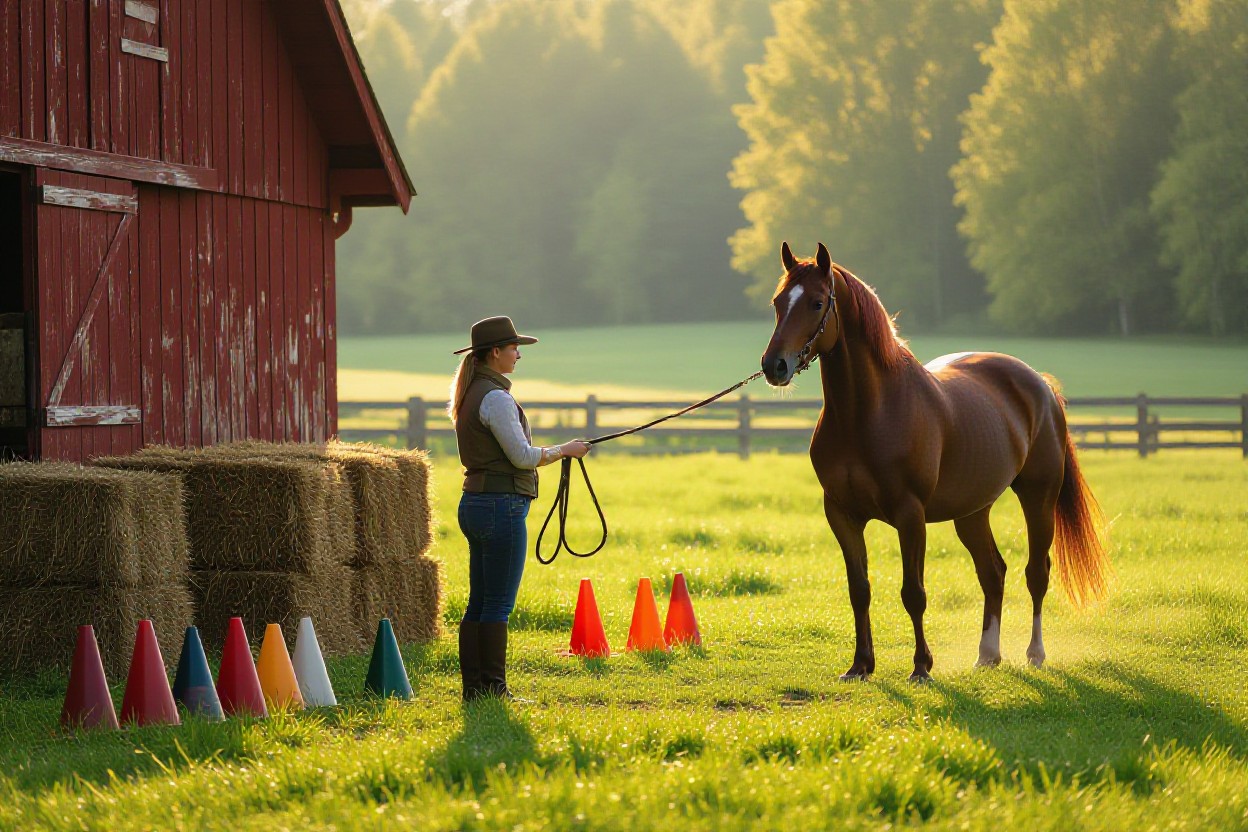
Morning Routine
By 5:00–6:30 a.m. you’re already on the yard, feeding, turning out, and doing quick health checks for each mount; with typical stables handling 6–12 horses, you prioritize colic signs, fresh manure, and circulation issues first. Many trainers log morning findings in a notebook or app to track what horse trainers do in a day and flag any vets or farriers needed.
Personal Hygiene and Breakfast
You wash hands, wipe boots, and change into clean base layers to limit bacterial and dust transfer; then you grab a quick high-protein breakfast—eggs, oats, or a 400–600 kcal smoothie—so you sustain energy for heavy work. Always keep a spare shirt and gloves in the truck, and use a face mask in dusty barns to reduce respiratory risks.
Daily Planning and Scheduling
You block the day into focused slots—typically 45–60 minutes per ridden horse, 15–30 minutes turnout checks, plus 10–20 minutes for client calls—so a busy trainer manages about 6–8 horses daily. Weather and vet availability influence priorities, and you update the whiteboard or app each morning to reflect changes and safety notes.
For example, a dressage specialist may schedule two 60–90 minute schooling sessions per high-level horse, while a racing yard sets gallop windows at 5:30–7:00 a.m.; you use tools like BarnManager or Google Calendar to assign staff, record heart rates, and attach gait videos. Weekly targets often include one cumulative fitness metric and a single vet/farrier appointment per horse.
Equipment Preparation
You inspect saddles, girths, bridles, and bits before the first ride, checking stitching, billet wear, and stirrup safety; tack-up usually takes 10–20 minutes per horse. Keep a ready first-aid kit, hoof pick, and spares, and mark any gear with faults—frayed billets or cracked stirrups get retired immediately to avoid accidents.
In practice you replace girths or stirrup leathers after visible wear or roughly every 2–3 years (or ~200 rides), condition leather weekly, and keep inventory lists for spares like halters and lead ropes. Also pack rider PPE—helmet, body protector—and a basic toolkit so you can fix minor tack failures on the spot and prevent downtime.
First Training Session
Warm-Up Exercises
You start with a structured 10–15 minute warm-up: 5–8 minutes at the walk, 3–5 minutes trot with transitions, and targeted lateral flexion and pole work to engage the core. You watch for uneven rhythm and shortened stride or heat in a leg, which signal problems. Using ground poles at 12–18 ft spacing helps regulate stride length quickly and reduces risk of strain before more intense work.
Rider’s Responsibilities
You perform a rapid tack and fit check—2–3 minutes to verify girth, saddle balance and stirrup length—then put on safety gear (helmet, boots, gloves). You set clear, measurable goals for the ride (e.g., five balanced 20‑meter circles) and maintain consistent aids: weight, leg, and rein. Proper tack fit and rider position prevent injury and improve training response.
More detail matters: you monitor your seat and hip alignment every rep, using a mirror or pole markers to confirm symmetry. If the horse pins ears, tosses its head, or shortens stride, you pause and check tack, then reintroduce a simple exercise—five calm halts and walk breaks—to reset focus. High‑level riders use timed intervals (3 minutes work/2 minutes walk) and log outcomes in a notebook or app to track progress across sessions.
Horse Assessment and Feedback
You assess gait symmetry, impulsion, contact and responsiveness to aids within the first 10 minutes, noting heart rate (rest 28–44 bpm; recovery within 10 minutes post‑work). You record video for later review and give immediate, specific feedback to the rider: “soften left rein, two louder leg aids.” Objective measures and quick corrections keep the session efficient and safe.
In practice you combine subjective observation with tools: a heart‑rate monitor shows workload, a slow‑motion phone clip highlights a 10% drop in left‑hind stride, and a simple 5‑point checklist (balance, rhythm, contact, straightness, impulsion) guides decisions. For example, if stride length drops 8% on the right over two sessions, you schedule two pole sessions and a vet check; if everything improves by ≥10% after three rides, you progress to lateral suppling exercises.

Horse Care Duties
Feeding and Grooming
You plan and portion rations: most adult horses eat about 1.5–2% of bodyweight in forage (for a 500 kg horse that’s ~18–22 lb hay) plus grain or supplements as needed, split into 2–4 feedings. Grooming runs 15–45 minutes per horse—curry, mane/tail care, hoof picking—and you watch for skin issues or ticks. Sudden feed changes or missed water can trigger colic or dehydration, so you log feed swaps and check troughs multiple times daily.
Health Monitoring
You perform daily checks: temperature (normally 99–101.5°F), pulse (28–44 bpm), respiration (8–20/min), manure consistency, appetite and gait. Lameness, heat in a hoof, or prolonged fever are red flags that prompt immediate vet contact. Quick digital notes after each ride help you spot trends before they become injuries or metabolic problems.
In practice you follow schedules: fecal egg counts every 8–12 weeks to guide deworming, annual vaccines (tetanus, EWT), dental floats every 6–12 months and farrier visits every 6–8 weeks. For example, a trainer I worked with caught early laminitis by recording a subtle change in hoof temperature and appetite, then altered turnout and vet treatment, saving the season and avoiding long-term damage.
Administrative Records for Care
You keep organized records: vaccine dates, deworming logs, dental and farrier invoices, medication dosages and lot numbers, injury reports and owner communications. Many trainers use BarnManager, EquineNote or Google Sheets so entries are searchable; paper charts work if legible. Missing or incorrect entries can complicate insurance claims or liability disputes, so you label every treatment with date and signature.
Make entries specific: horse name, date, weight estimate, drug name, dose in mg/kg, lot number and administrator. Retain records for at least 3–5 years; expect to spend roughly 10–20 minutes daily on a 10-horse barn. In one claim case, access to dated vaccine receipts within 12 months resolved a liability dispute and reduced payout delays.
Mid-Morning Break
Typically a 15–30 minute pause around 9:30–10:30, the mid-morning break gives you a window to hydrate, check tack, and scan barn logs. In larger yards you’ll stagger breaks so exercise riders keep the schedule; in a racing string you might take shorter, more frequent rests between gallops. Hydration and a quick equipment check cut down on injuries and lost time.
Refueling with Snacks
You pack portable, calorie-dense snacks—think a 300–400 kcal energy bar, 20 g protein jerky, or a banana with nuts—to sustain an 8–12 hour day. Many trainers keep a cooler with sandwiches and electrolyte drinks, avoiding sugary sodas that spike and crash energy. Consistent protein and complex carbs help you stay sharp during back-to-back sessions.
Staff Communication
You run a 5–10 minute huddle after the break to align on horse status, exercise orders, and tack swaps; communication tools often include a whiteboard, WhatsApp group, or two-way radios. For a 20–horse operation you’ll typically assign 3–4 grooms and log any health flags so everyone knows priorities. Clear handoffs prevent missed checks and accidents.
In practice you document three key items each huddle: horses with altered feeds, riders assigned to specific schooling exercises, and any veterinary observations from the morning. Use a simple checklist—name, issue, action—to reduce errors; studies in stable management show checklists cut oversight by over 30%. When a horse shows a subtle limp, immediate messaging to the vet and a treatment plan logged on the board keeps the whole team synchronized.
Reviewing Progress and Adjustments
You spend 10–20 minutes reviewing training logs, session videos, and data from heart-rate or GPS devices to compare today’s performance to the past 7–14 days. For example, if a young dressage horse shortens its canter stride by 10% versus last week, you’ll note that and tweak the plan. Data-driven adjustments sharpen results.
Digging deeper, you analyze objective markers—resting heart rate (typically 28–44 bpm), recovery time, and gait symmetry—and subjective notes on focus or tension. Then you decide on concrete changes: alter a feed ration by 0.5–1 kg, substitute polework for a fast gallop, or switch bits for better steering. Logging the change and expected re-evaluation date (3–7 days) ensures measurable progress and faster troubleshooting.
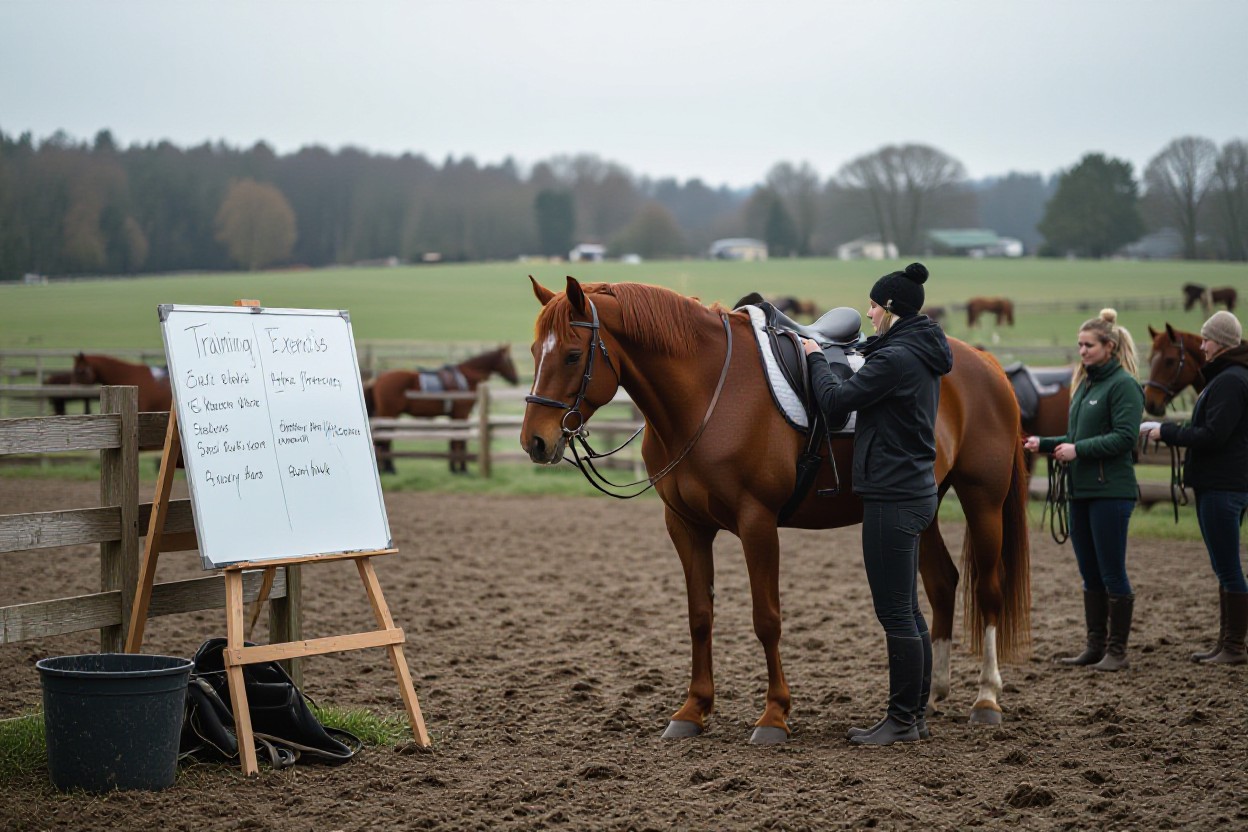
Second Training Session
You schedule the second session mid- to late-afternoon, typically 30–60 minutes depending on fitness goals; for example, a dressage horse gets a 40-minute schooling with 10 minutes focused on collection, while a race prospect does 20–30 minutes of interval gallop sets. You prioritize a measured warm-down and hydration, and you log each session’s duration, intensity and any behavioral notes so you can track progress week-to-week.
Advanced Techniques
You layer in advanced work once basics are solid: lateral movements (shoulder-in, travers), flying lead changes, and tempo modulation. You might program a 15-minute collection block, then a 10-minute extension block, and finish with pole grids to refine rhythm. Use progressive overload—add 5–10% intensity per week—and monitor recovery closely.
- Pole grid sequence: 6–8 poles, 2.5–3.5 m spacing for canter rhythm.
- Shoulder-in progression: 3 sets × 6–8 strides per side, increasing bend.
- Counter-canter sets: 4–6 reps, 20–30 seconds each to build balance.
- Hill sprints: 4 × 20–30 second uphill canters for power development.
Advanced Technique: Purpose vs Cue
| Technique | Key Cue / Benefit |
|---|---|
| Shoulder-in | Inside leg at girth / improves lateral suppleness |
| Flying changes | Half-halt + leg aid / improves straightness and cadence |
| Pole grids | Rhythm-focused rein/leg coordination / reduces rushing |
| Hill work | Short spurts uphill / builds hind-end strength |
Evaluating Horse Behavior
You read subtle cues: ear orientation, tail swishing, head carriage and movement symmetry. Use objective markers—resting heart rate ~30–40 bpm, recovery to <60–80 bpm within 10 minutes—and note deviations. Watch for pinned ears, repeated stumbling, excessive sweating or refusal patterns as indicators of fatigue, pain, or stress.
For example, if a 7-year-old mare’s recovery HR is 120 bpm ten minutes post-session, you reduce intensity by ~20% and add more walk breaks; if ear pinning coincides with gait changes, you perform a focused lameness check and consult your vet. Videoing sessions and scoring behavior (scale 1–5) every ride lets you quantify trends and make evidence-based adjustments.
Problem-Solving During Training
You address problems with a stepwise approach: stop the escalation, re-establish basics, and introduce a targeted drill. For issues like bolting or rearing, prioritize handler safety—disengage, circle, and reset—and treat those behaviors as dangerous until safely extinguished. Use short, specific exercises and positive reinforcement to rebuild trust.
Take a 6-year-old OTTB that rushes the left lead: you start with 10 minutes of lunge work with transitions every 30–60 seconds, follow with pole work to moderate stride length, and finish with controlled canter depart exercises. Over two weeks of consistent reps (5 sessions/week), rushing frequency often drops by ~60% and smoother leads return; if not, escalate to a vet or behavior specialist for medical or deeper behavioral evaluation.
Lunch and Rest Period
As part of what horse trainers do in a day, most yards schedule a 30–60 minute lunch break between morning turnout and afternoon schooling; you’ll eat, check tack, update training notes and often do quick stall checks. Larger operations stagger breaks so coverage remains, while in smaller barns you may combine eating with light admin—emails, ride logs, or planning the next session—before returning refreshed for afternoon work.
Importance of Breaks
Short, regular breaks cut down on physical and mental fatigue that leads to handling mistakes and injuries; you’ll notice reaction times drop if you push through six-plus hours without respite. In practice, trainers schedule at least one substantial break midday and tiny 5–10 minute pauses between rides to stretch, rehydrate, and inspect hooves and tack so accidents and equipment failures are less likely.
Nutritional Choices for Trainers
You should aim for a balanced lunch of roughly 400–700 kcal with 20–30 g protein and ample complex carbs to sustain energy—think whole-grain wraps with turkey, a quinoa bowl, or a hearty salad with beans. Pack portable snacks (nuts, fruit, yogurt) and sip electrolyte drinks on hot days to avoid dehydration and the sluggishness that heavy fried meals cause.
For finer detail, eat a 150–250 kcal snack 30–45 minutes before the afternoon session—banana with peanut butter, a 20–25 g carb energy bar, or Greek yogurt—to stabilize blood sugar and prevent mid-session crashes. Keep a 500 ml water bottle handy and top up throughout the morning; on high-sweat days add 300–500 ml of electrolyte drink midday. Use an insulated cooler for perishables and rotate meals weekly to maintain variety without extra prep time.
Mentally Resetting for the Afternoon
You’ll use the break to reset focus: a quick 5–10 minute breathing exercise, a 10–20 minute power nap, or a walk around the paddocks sharpens judgment and reduces stress. Many experienced trainers run a short checklist during lunch—goals for each horse, tack adjustments, and client updates—so you return with a clear plan and fewer on-the-spot decisions.
Going deeper, combine a physical reset with mental prep: review the morning video clips, mark specific cues to reinforce, and prioritize three tasks per horse for the afternoon; this method reduces cognitive load and helps you manage time when barn activity spikes. In high-pressure environments like racing stables, teams often hold a two-minute huddle post-lunch to align roles, which cuts miscommunication and keeps safety standards high.
Afternoon Stable Duties
Cleaning and Maintenance
You tackle stall cleaning and barn upkeep mid-afternoon: muck stalls twice daily, removing wet spots and manure, and you aim to deep-clean 10 stalls in about 45–60 minutes using a wheelbarrow and pitchfork. You change bedding to a depth of roughly 4–6 inches for comfort, scrub water buckets, clear feed tubs, and sweep aisles. Keep an eye on drains and ammonia buildup, since poor ventilation raises respiratory risks; weekly disinfecting and a monthly full bedding change cut disease spread and improve turnout readiness.
Handling New Horses
You run intake checks immediately: estimate weight, review vaccination and deworming records, and perform a basic behavior assessment in a round pen for 30–60 minutes. You start with haltering, leading, and picking feet, breaking tasks into short 10–15 minute sessions to avoid overloading the horse. Note any kicking, bolting, or aggressive biting on the intake sheet and set a 14-day quarantine to monitor health before group turnout.
You then implement a phased training plan: Days 1–7 focus on habituation to touch, trailer, and handler presence with 3–4 brief sessions daily; Weeks 2–4 introduce lunging with a cavesson, saddle fit checks, and light desensitization (flags, tarps). You document each session in a log with dates, times, and responses—many trainers report faster progress when using consistent, measurable steps and clear milestones.
Equipment Management
You inspect and maintain tack after afternoon work: clean leather (oil every 7–14 days), check girths, billets, and stirrup leathers for fraying or cracks, and replace any item with compromised stitching to prevent equipment failure. You also rotate and launder saddle pads weekly and keep a labeled inventory of bits, bridles, and blankets so you can source spares quickly. Prioritizing this reduces training interruptions and prevents dangerous equipment failures.
You organize the tack room with hooks, labeled bins, and a simple inventory sheet—on a 20-horse yard you might stock 40 saddle pads and 10 spare halters. You schedule clipper blade sharpening monthly, keep a repair kit (needle, strong thread, spare billets, duct tape), and log replacements; this systematic approach saves both time and money while keeping riders and horses safe.
Business and Admin Responsibilities
As you balance what horse trainers do in a day, expect to spend 1–3 hours on business tasks: booking, billing, equipment orders, insurance checks, and marketing. You’ll juggle client intake forms, waivers, and permits while tracking herd inventory (tack, supplements). Many trainers automate with scheduling apps and send 2–3 social posts weekly to attract clients; outsourcing bookkeeping can free up time for training and barn rounds.
Client Communication
You handle 20–40 messages daily: lesson confirmations, progress videos, behavior updates, and urgent vet notices. You write clear homework plans after each session and follow up within 24 hours; when there’s risk of injury or aggression you escalate immediately and note it in the horse’s file. Clear, honest updates retain clients and reduce no-shows.
Scheduling Future Sessions
You block 30–90 minute slots based on lesson type and horse fitness, leaving 15–30 minute buffers for tack changes or emergencies. You enforce a 24–48 hour cancellation policy and aim for a weekly load of 15–25 lessons to balance riding time with admin and horse care.
You also use analytics from booking software to track peak demand—mornings 6–9am and evenings 4–7pm—and adjust prices or add weekend clinics to hit revenue goals. Offering package discounts (5–10% for 5+ sessions) boosts retention and smooths cash flow.
Record Keeping and Finances
You log income and expenses daily: lesson fees, training board, feed ($50–200/month per horse), farrier and vet costs, and equipment purchases. You invoice weekly or use automated recurring billing, reconcile bank statements monthly, and keep client records (consent, vaccination) organized for liability and service continuity.
You rely on tools like QuickBooks or Wave, categorize costs for quarterly tax estimates, and track profitability per horse or program. When you employ staff, payroll, workers’ comp, and insurance become ongoing line items—missing these can create major legal and financial risk, so you set calendar reminders for filings and renewals.
Specialization Types
You’ll find yards split by focus: performance, pleasure, rehab, or end-of-life care, and each demands different daily rhythms—some days are all lunging and flatwork, others are vet calls and paperwork. You often manage 3–6 horses per discipline, teach riders, and prep for shows or sales. Horse trainers do in a day varies by niche, from high-intensity gallop sets to slow rehab walks. The specialization you pick directly changes your schedule, income potential, and on-the-job risks.
- horse trainers do in a day
- daily schedule
- training sessions
- administrative tasks
- horse care duties
| Dressage | Precision schooling, 30–60 min ridden sessions, competition prep to FEI levels; technical focus |
| Jumping | Gymnastic grids, fence work, 40–90 min sessions, fall and injury risk management |
| Western | Pattern work, ranch tasks, long reining, often multiple short sessions per day; practical skills emphasis |
| Racing | Gallop sets, interval conditioning, 4–6 rides/day for some gallopers; high-speed risk and strict conditioning |
| Therapy & Rehab | Slow rehab plans, 4–12 week programs common, close vet/physio coordination and low-impact exercise |
Dressage and Jumping Training
You’ll split time between flatwork and fences, typically running 2–4 focused sessions per horse weekly; sessions last 30–75 minutes depending on age and level. Expect to video sessions, set measurable goals (e.g., improve lateral work or clear 1.20–1.30m courses), and manage warm-up/cool-down to reduce injury risk while boosting competition readiness.
Therapeutic Riding Programs
You coordinate lessons for riders with physical, cognitive, or emotional needs, often working with 6–12 participants per weekly schedule. Sessions run 30–45 minutes, require trained volunteers, and demand strict safety plans; the work delivers measurable benefits such as improved balance and confidence.
You implement individualized plans based on therapeutic goals, track progress with baseline metrics (balance, gait symmetry, rider independence), and liaise with therapists and families. You also maintain adaptive tack, train horses for steady temperaments, and schedule regular assessments—typical programs run in 6–12 week blocks with documented outcomes for funding and referrals.
Retirement and Rehabilitation Services
You manage slow, low-impact programs for older or injured horses, balancing turnout, hand-walking, and controlled tack work; rehab often spans 4–16 weeks with daily monitoring. Your priorities include pain management, gradual conditioning, and clear communication with owners about realistic timelines and costs.
You create phased plans—immobilization, passive mobilization, light exercise, then reconditioning—with vet-approved milestones and weight-bearing checks. Expect to log daily vitals, adjust feeds for metabolic issues, and coordinate farrier and physio visits; successful rehabs reduce re-injury rates and often extend a horse’s usable life in retirement or light riding.
Challenges in Horse Training
You face a mix of physical labor, behavioral puzzles and client pressures daily; typical days can stretch to 12–14 hours when prepping arenas, rehabbing a problem horse and handling paperwork. You deal with injuries, unpredictable behavior and weather interruptions that can shift a week’s plan in a single morning, so you need clear priorities, backup plans and a steady risk-assessment process to keep horses and people safe.
Dealing with Difficult Horses
You often spend 30–50% of weekly training time on horses with specific issues — bolting, cribbing, or anxiety — using techniques like desensitization, lunging and incremental exposure. You must balance progress with safety: a frightened horse can cause serious injury, while consistent, patient work yields measurable gains in 4–8 weeks for many behavioral problems. You log sessions and adjust goals after each ride.
Weather and Environmental Factors
Rain, deep mud, extreme heat (>32°C / 90°F) and frozen footing directly change how and when you train, forcing you to shift from ridden work to groundwork or in-hand exercises; indoor arenas and spaces with good footing cut cancellations, while insufficient shelter increases respiratory and hoof risks. You monitor forecasts and adjust schedules to protect horses and maintain steady progress.
- horse trainers do in a day
- daily schedule
- training sessions
- horse care duties
- weather adaptation
On wet weeks you shift 60–80% of sessions to lunging, ground poles and desensitization drills to protect tendons and improve balance; in summer you shorten ridden sessions to 15–25 minutes at peak heat and hydrate horses before and after work. Perceiving micro-changes in gait and attitude during these altered sessions tells you when to stop, stall-turnout instead, or call a vet.
Client Expectations and Satisfaction
You juggle clients who expect quick fixes, regular updates and measurable results; typical communication involves 1–2 weekly progress emails, video clips and a 30–45 minute planning call every 2–4 weeks. You set realistic timelines—basic manners in 6–12 weeks, complex behavioral rehabilitation in 3–12 months—and document outcomes to align expectations and reduce disputes.
Transparent pricing ($30–$80/hr typical depending on region and specialization), clear training plans with milestones and weekly videos help you retain clients and build referrals; offering a 30-day reassessment window reduces churn and clarifies goals. Perceiving shifts in a client’s priorities early lets you renegotiate scope before trust erodes.
Career Path in Horse Training
You progress from grooming and stall chores to running training programs; many trainers start as grooms or working students and spend 1–5 years apprenticing before taking clients. You’ll choose to specialize (dressage, racing, western) to increase demand, balance daily hands-on work with client communications, and face the physical risks of handling horses. Typical earnings vary widely—most earn between $25,000–$70,000 annually, while top specialists exceed $100,000 with proven results.
Necessary Qualifications and Certifications
You should obtain basic certifications: equine first aid, BHS Level 2/3 (UK) or PATH Intl. instructor credentials, and US Equestrian/FEI accreditation if competing internationally. Many employers expect 1–3 years of documented hands-on experience plus vaccinations, biosecurity training, and a farrier/facility safety course. These credentials show competence for clients and insurers, and you’ll often need to renew courses every few years.
Building Experience and Reputation
You build reputation by logging practical hours—aim for 1,000+ training hours across different horse types—and by compiling a portfolio of videos, client testimonials, and competition placings. Working under a respected trainer for 2–4 years accelerates learning, while taking on young or off-the-track Thoroughbreds demonstrates versatility. Consistent, measurable progress in horses is what convinces clients to hire you.
You should pursue concrete milestones: enter 5–10 local shows a season to collect results, retrain 10–20 OTTBs or problem horses to show case studies, and maintain before/after video playlists. Offering short-term training contracts or trial lessons generates referrals; one trainer grew from part-time to full-time within four seasons by focusing on OTTB retraining and social-proof videos that documented weekly progress.
Networking and Professional Development
You expand opportunities by joining associations (PATH Intl., US Equestrian), attending 2–4 industry clinics or conferences yearly, and maintaining a professional online presence showcasing daily work. Mentorships and local chapter meetings produce client leads and referrals; many trainers get >50% of new business from word-of-mouth. Ongoing education keeps your methods current and defensible.
You can host mini-clinics, volunteer at race meets or breed shows, and collaborate with vets or farriers to build referral networks. Posting weekly training reels and client testimonials on Instagram and Facebook converts viewers into local clients; trainers who post consistently often see a measurable uptick in inquiries within 3–6 months. Prioritize in-person connections plus an active online profile to scale your business.
Income and Financial Aspects
Average Earnings by Specialization
You typically see wide ranges: entry-level handlers or assistant trainers often earn $20,000–$35,000 annually, while established dressage and western trainers commonly reach $40,000–$80,000; racing trainers can earn $60,000–$150,000+ with top barns taking millions from stakes. You should factor on-season spikes and client retention when estimating yearly pay. Any earnings estimate must account for board, travel and percentage-based purses or lesson revenue.
- horse trainers do in a day — shows why specialization changes income sources
- dressage — lesson and competition fees drive steady income
- racing — purse percentages and bonuses create high upside
Factors Influencing Income Levels
Your pay hinges on location, client base, barn size, and whether you take a percentage of winnings or charge flat training fees; city riders and show circuits often pay more. You also feel the impact of your reputation, certifications, and the number of horses you manage; high vet bills and seasonal demand create variability. Any factor can swing your take-home pay by tens of thousands annually.
- horse trainers do in a day — daily tasks reflect billable activities versus overhead
- reputation — top riders/owners pay premiums
- location — urban/suburban circuits yield higher rates than rural areas
You should quantify income drivers: many racing trainers earn a 10–15% cut of purses plus training fees, so a 100k purse season can add $10k–$15k to revenue; lesson-based trainers charge $40–$150 per hour and scale via clinics and packages. You also benefit from boarding and rehabilitation services—10 boarded horses at $400/month equals $4,000 gross. Any single high-profile client or major win can shift annual income significantly.
- horse trainers do in a day — shows how daily billable hours convert to monthly revenue
- training fees — retainer models stabilize cash flow
- purse percentage — creates variable, high-reward income streams
Financial Management Tips for Trainers
You should diversify income—mix lessons, training, boarding and event coaching—and set clear contracts with deposits; aim for a 20–30% tax reserve and an emergency fund covering 3–6 months of expenses because vet emergencies and seasonal downturns hit cash flow hard. Perceiving monthly cash flow swings lets you plan for slow seasons.
- horse trainers do in a day — use daily logs to track billable vs. non-billable time
- emergency fund — protects against sudden vet or facility costs
- insurance — liability and mortality policies reduce catastrophic losses
You should use simple bookkeeping: invoice templates with 50% upfront on new training contracts, cloud accounting (QuickBooks, Wave), and categorize expenses—feed, farrier, fuel, and payroll—to claim legitimate deductions. Consider forming an LLC for liability protection and separate business banking to simplify taxes; target a 15–25% gross margin on services after direct costs. Perceiving these metrics monthly helps you spot losing services and scale profitable ones.
- horse trainers do in a day — daily revenue tracking reveals profitable activities
- tax reserve — set aside a percentage each payment cycle
- retainer — secures cash flow and reduces client churn
Summing up
To wrap up, when you look at what horse trainers do in a day, you see a structured blend of early morning care, multiple focused training sessions, tack and facility upkeep, client communication, and administrative work, with demands varying by specialization. Your schedule requires physical stamina, teaching skills, business savvy, and ongoing education, and it offers clear progression and income potential if you build reputation and strong client relationships.
FAQ
Q: What does a typical workday of horse trainers look like?
A: A typical workday for horse trainers depends on the facility, the discipline, the time of year and the trainer’s role, but there are consistent building blocks that define what horse trainers do in a day. Most days are long, structured around horses’ biological rhythms and clients’ schedules, and blend hands-on horsemanship with business and coordination tasks. Below is a realistic, hour-by-hour example plus the routine tasks that repeat daily.
Example daily schedule (typical full-time training barn)
– 4:30–6:30 a.m.: Morning barn check and first turnout/feed. Arrive early to let temperatures stabilize, check water, administer any morning medications or supplements, and perform a quick health check (respiration, gut sounds, wounds, lameness). Put out hay, measure grain rations, and begin blanketing or cooling as needed.
– 6:30–9:30 a.m.: Morning training block. This is prime time for ridden work and ground training when horses are freshest. Warm-ups, flatwork, conditioning sets (trot/canter sets, hill work, interval conditioning), or schooling over fences depending on discipline. Trainers will tack up, ride multiple horses consecutively, and supervise assistant riders.
– 9:30–10:30 a.m.: Cooling down, grooming, leg care, and first stall checks after training. Treatments such as poultices, wraps, or cold hosing are applied. Trainers log notes in each horse’s chart about behavior, fitness, tack fit, and any concerns.
– 10:30 a.m.–12:30 p.m.: Lessons and client coaching. Many trainers teach private or group lessons to generate income and maintain client relationships. Lesson prep includes planning exercises, setting fences or cones, and debriefing with riders.
– 12:30–1:30 p.m.: Midday chores and lunch. Refill feed, clean water buckets, remove manure, and reset turnout as required. Short administrative check-in—responding to urgent emails or confirming appointments.
– 1:30–4:30 p.m.: Second training block and sales/prep work. Race trainers might send horses to gallop or make work at the track in the afternoon, while show trainers focus on specialized schooling, show prep, or sales horses. This block includes farrier or vet appointments when scheduled and more one-on-one sessions.
– 4:30–6:30 p.m.: Evening barn work. Final turnout changes, evening feeding, stall cleaning if not delegated, and final health checks. Trainers ensure horses are safe, comfortable and all treatments are applied before leaving.
– 6:30–9:00 p.m.: Administrative hours. Trainers update training logs, send client reports and videos, invoice clients, order supplies, schedule farrier/vet visits, market horses for sale, and plan the next day’s training schedule.
Core daily tasks and time allocation (typical proportions)
– Hands-on horse care (feeding, mucking, turnout, grooming): 25–35% of the day
– Training and riding (conditioning, lessons, specialized schooling): 30–40%
– Client interaction (lessons, phone/video updates, evaluations): 10–15%
– Administration and business management (billing, scheduling, marketing): 10–20%
– Coordination with professionals (vets, farriers, transporters): 5–10%
Routine activities described
– Morning routines: Health checks, feeding, turnout logistics and prioritizing horses with special medical or dietary needs.
– Training sessions: Warm-up protocols, progressive conditioning plans, discipline-specific exercises (flatwork for dressage, pattern work for western, interval gallops for racehorses), cool-down and wrap routines, and saddle/tack checks to prevent soreness.
– Horse care duties: Stable management (mucking, bedding), wound care or medication administration, stall management, blanketing, hoof care coordination, and monitoring for behavioral changes indicating injury or illness.
– Administrative tasks: Daily logs and training diaries, video reviews and sending clients training notes, invoicing and bookkeeping, procurement of feed and supplies, liability insurance management, and staff scheduling.
Seasonal and weekly variations
– Show weeks: More travel prep, tack checks, clipping, shipping paperwork, and longer days at events.
– Off-season: Focus shifts to conditioning, rehab, sales prep, and course design or facility maintenance.
– Race season: Early morning gallops, transport coordination, and frequent veterinary interactions.
This model reflects a career-focused view of a trainer’s daily rhythm: long days, varied tasks blending physical labor and business responsibilities, and a schedule driven by the horses’ needs and clients’ expectations.
Q: How do daily routines vary by specialization and what tasks occupy most time in different disciplines?
A: Specialization dramatically changes the composition of a trainer’s day. The basic pattern—mornings for barn care and key training, afternoons for additional rides and admin—holds, but the specific tasks, intensity and timing differ depending on discipline. Below are common specializations with a realistic breakdown of daily priorities and time spent.
Dressage and show jumping trainers
– Focus: Quality flatwork, suppleness, precision, and gymnastic grid work.
– Typical day: Multiple short, technical schooling sessions emphasizing repetition and refinement. Trainers spend extensive time on warm-up, transitions, lateral work, and jumping exercises. They film sessions for biomechanical analysis and client feedback.
– Time split: Technical schooling and ridden sessions 40–50%, lessons/coaching 20–30%, tack fit and equipment maintenance 5–10%, admin 10–15%.
– Unique tasks: Regular saddle checks, rider biomechanics coaching, designing courses, and pre-show grooming and braiding.
Western trainers (reining, cutting, horsemanship)
– Focus: Responsiveness, collection, and maneuverability for specific patterns.
– Typical day: Groundwork, desensitizing, cue refinement, and specialty drills. Trainers often work with young horses on starting cues and rein control, and spend long stretches on ground-driving or pattern practice.
– Time split: Under-saddle/ground training 45–55%, horsemanship lessons 20–25%, equipment upkeep (bit tuning, tack) 5–10%, admin 10–15%.
– Unique tasks: Transitioning young horses to specialized bits, working cattle for cutting/reining practice, and conditioning for speed/stamina.
Racehorse trainers
– Focus: Peak cardiovascular performance, readiness for race day, and strict conditioning schedules.
– Typical day: Very early starts at the track; morning gallops or timed works, followed by cooldowns and feedings. Trainers coordinate closely with jockeys, exercise riders, vets and grooms. Stable work continues in the afternoon, and owners expect detailed reports after each work.
– Time split: Gallops/track work 35–50%, stable care and medication management 20–25%, owner communication and entries 10–20%, transport and race logistics 5–10%.
– Unique tasks: Bloodwork and vet monitoring, weight management, shipping to tracks, and monitoring race entries and handicapping decisions.
Eventing and cross-country trainers
– Focus: Multi-phase conditioning, cross-training, and injury prevention.
– Typical day: Mix of flatwork, stadium schooling and cross-country conditioning. Trainers implement fitness plans with hill work, intervals, and technical schooling over varied terrain.
– Time split: Conditioning and multi-discipline schooling 45–50%, course building/maintenance 5–10%, client lessons 20–25%, vet/farrier coordination 5–10%.
– Unique tasks: Course reconnaissance, schooling over diverse obstacles, and systematic conditioning plans to balance fitness and recovery.
Sales and prep trainers
– Focus: Preparing horses for sale—presentation, under-saddle manners, and sale videos.
– Typical day: Training to build walk/trot/canter consistency, confidence under tack, and “broke” manners. Much time is spent on grooming, braiding, photography/video, and running horses through sales trials.
– Time split: Under-saddle schooling and ground manners 40–50%, marketing and listing prep 20–30%, client/agent communication 10–15%, transport coordination 5–10%.
– Unique tasks: Creating sales campaigns, producing digital media, pricing strategy, and managing trial logistics.
What tasks eat the most time regardless of specialization
– Feeding and turnout logistics: Every trainer spends daily time ensuring nutrition and turnout schedules are met.
– Horse health monitoring and treatments: Early detection and consistent care reduce long-term downtime, so this is a daily priority.
– Client communication and reporting: Owners expect routine updates; building trust through clear, frequent communication is a major time commitment.
– Business tasks: Booking shows, invoicing, payroll for grooms, ordering supplies and marketing are ongoing tasks that determine long-term viability.
Implications for career planning
– Specialization dictates equipment needs, facility layout and the trainer’s network (breeders, race tracks, show circuits). Income streams and peak work seasons differ: race trainers face intense track schedules, while sales trainers rely on market cycles and show trainers on competition seasons.
Q: What should aspiring trainers know about physical demands, income potential, education and career progression?
A: A career as a horse trainer combines hands-on physical labor, horsemanship expertise, business management and client service. Prospective trainers should plan for an apprenticeship route, ongoing education, varied income streams and realistic physical demands.
Physical demands and workplace realities
– Hours: Expect 10–12 hour days commonly; show weeks and race meets can push 14+ hour days. Weekends and holidays are typical workdays.
– Physical tasks: Lifting hay bales, moving buckets, mucking stalls, handling large animals, towing trailers, and bending/standing for long periods. Strong core, back and shoulder condition help, plus good cardiovascular fitness.
– Weather and environment: Work continues in rain, heat and cold; protective clothing and hydration strategies are important. Injury risk includes kicks, bites, falls and overuse injuries.
– Safety measures: Use safe handling techniques, maintain well-fitted PPE (boots, helmets for riding), ensure proper tack fit, and implement ergonomics when lifting.
Income potential and typical revenue streams
– Salary range: Highly variable by region, clientele and specialization. Entry-level stable hands or assistant trainers may earn minimum wage to $25k–$35k annually; mid-level trainers often earn $30k–$60k with lessons and partial training board; high-profile or specialty trainers (top show, successful race trainers) can earn $100k+ including commissions, training fees and prize money.
– Revenue sources:
– Training fees: Monthly training board (full training vs partial), per-day training rates.
– Lessons: Private and group lesson fees provide steady cash flow.
– Sales commissions: Percentage of sale price for horses sold.
– Competition winnings and percentages: Race trainers may take a percentage of winnings; show trainers may receive bonuses for results.
– Breeding and sales prep: Preparing youngstock and sales horses adds revenue.
– Additional services: Clinics, coaching, clinics, and online coaching can diversify income.
– Business costs: Feed, bedding, veterinary/farrier costs, insurance, payroll, facility maintenance, and transportation must be factored into pricing. Net income varies widely after overhead.
Education, training and career progression
– Formal education: Degrees in equine science, animal science or equine business are helpful but not mandatory. Practical experience outweighs classroom credentials in many stables.
– Apprenticeships and internships: Most trainers learn through multi-year apprenticeships, working as grooms or assistant trainers under experienced professionals. This is the primary pathway to technical competence, network building and client trust.
– Certifications and continuing education: Certifications from recognized bodies (USEF, Parelli, British Horse Society equivalents) and continuing education in sports medicine, equine behavior, saddle fit and nutrition enhance credibility.
– Skills to develop: Horsemanship fundamentals, problem-solving, communication, marketing, bookkeeping, and an understanding of equine nutrition, biomechanics and basic veterinary care.
– Career ladder:
– Stable hand/groom: Entry-level, daily horse care.
– Assistant trainer: More riding, lesson coaching, and expanded decision-making under supervision.
– Head trainer: Full program management, business operations, client acquisition, and strategic planning.
– Specialized or high-performance trainer: Work with high-value clients or race barns, focus on elite competition or commercial sales.
– Entrepreneurial route: Opening a training/boarding facility or developing clinics, branded programs, and online content.
Practical tips for sustainability
– Build diverse income streams early: combine lessons, training, sales prep and boarding.
– Keep meticulous records: training logs, vet records, and client invoices build trust and protect the business legally.
– Network: Relationships with vets, farriers, transporters, and other trainers drive client referrals and opportunities.
– Invest in staff and delegation: Skilled grooms reduce burnout and allow the trainer to focus on higher-value tasks.
Summary perspective
– The job is physically demanding, emotionally rewarding, and entrepreneurial by nature. Income and daily structure depend heavily on specialization, client base and business acumen. Success typically follows years of hands-on experience, disciplined record-keeping, strong client relationships, and ongoing learning in equine science and business management.
